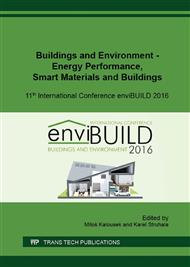p.343
p.353
p.361
p.369
p.376
p.384
p.392
p.401
p.409
Recommendations for Automatic Opening Vents (AOV) in an Office Building in Terms of Thermal Instability in Relation to Natural Ventilation and Cooling
Abstract:
One of the optimal and most economic ways of completing a thermal assessment of a building is with a precise dynamic thermal simulation, where a building envelope and its systems are simulated and evaluated in a virtual climate using real meteorological data. The simulation parameters can be exported to a Building Management System for a particular building, as simulation problems of natural ventilation reflects the real behaviour of a building. Instability of dynamic thermal simulation is a typical issue for certain conditions, as window operations can cause excessive interior temperature fluctuations and even trigger the heating system if the common ON/OFF or simple linear operation function is used. To solve the problem, reduction of the simulation time-step is usually used, though the principle of the air flow is not handled. Additionally this solution multiplies the simulation complexity, though the instability of the model is significantly reduced. The case model clearly showed a negative contribution of AOVs operated by linear function related to temperature or CO2 at initial simulations, by increasing the energy consumption of the building.
Info:
Periodical:
Pages:
376-383
Citation:
Online since:
December 2016
Authors:
Price:
Сopyright:
© 2017 Trans Tech Publications Ltd. All Rights Reserved
Share:
Citation:


